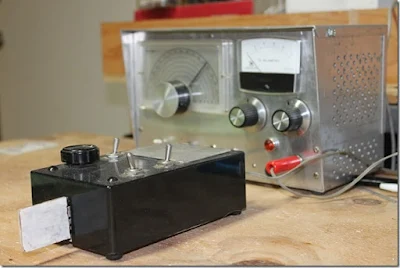Dear Bill
I hope that life’s treating you kindly over the left side of the pond. Your latest podcast really resonated with me as I’m hugely fond of junk box projects on a rainy afternoon. Fortunately Her Majesty’s weather men are generous...
Spy gadgets have long been a fascination of mine, particularly those disguised as harmless everyday objects. I remembered a Soldersmoke blog post a few months back showing a radio hidden inside a book. That got me thinking… then one rainy afternoon I stumbled across a half-used box of matches – surely an ideal enclosure for a covert spy transmitter!
Objectives:
1. The matchbox should remain fully functional and pass casual inspection
2. Transmitter, Morse key and battery should be hidden within the box
3. All parts should be cobbled-together from what I can find around the house
4. To build using “Manhattan style” construction for the first time
The transmitter borrows heavily from the Pixie 2 circuit and is based around two PN2222A transistors: the first forms a Colpitts oscillator for 7030kHz (plus/minus a smidgen of capacitor trim), the second acts as a modest Class C power amplifier (approximately 170mW out) – keying occurs here, to minimise chirp, before feeding a simple low-pass filter.
Discrete contacts set in the cardboard allow Morse to be keyed with my grandmother’s old sewing thimble – not only is this beautifully stealthy but it’s remarkably ergonomic too!
The transmitter can be easily teamed with an external receiver, selectable via a double-pole-double-throw switch. The switch simultaneously disconnects the battery, eliminating the audible whistle from the constantly-running oscillator.
This was my first experiment with “Manhattan style” construction and I can see why you swear by it. Even though I sketched the circuit’s layout before I started, I still found myself occasionally popping-off a square with a blade so as to optimise the tight packaging; Manhattan made this trivial, and fault-finding would have been easy with all connections on one side…
But remarkably the transmitter worked first time! Bench testing by calling CQ whilst monitoring the Reverse Beacon Network demonstrated that its tiny signal could be picked up as far away as northern France when driving my resonant end-fed antenna!
Ever since I discovered the magic of QSL cards I have always wanted to send one showing a hand-drawn diagram of my transmitter; perhaps I’ll now have a chance!
Please keep up the great work: you, Pete and the global brotherhood never cease to throw up new tricks for me to try. It’s a shame that this is perhaps one radio which I’d be best advised to not try to carry through airport security when my ever-patient girlfriend grants me permission for a holiday-time QRP operation...
73
Jonathan
M0JGH
--------------------------------
Earlier post about Jonathan: http://soldersmoke.blogspot.com/search?q=M0JGH








